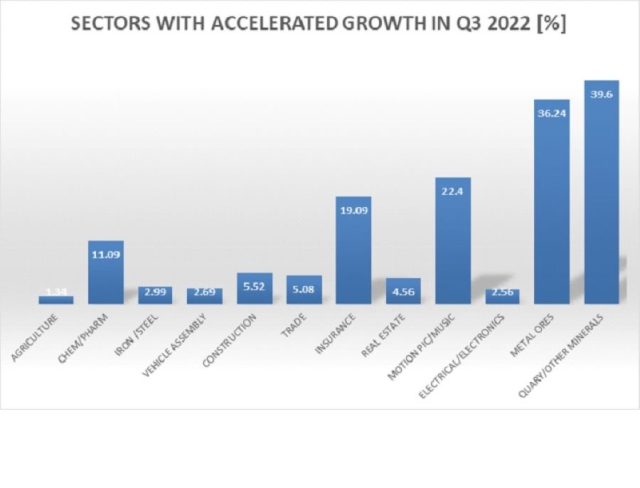…CPPE suggests fixes for the economy
MON. 28 NOV, 2022-theGBJournal| The Nigerian quarterly real GDP growth dipped to 2.25% in the third quarter of 2022, from 3.54% in the second quarter.
”This growth decline reflects the diverse headwinds that have been bedeviling the Nigerian economy,” says the Centre for the Promotion of Private Enterprise (CPPE) in a comment on the growth figures to theGBJournal.
These headwinds include: the macroeconomic instability, heightening inflationary pressures, currency depreciation, foreign exchange illiquidity, surging energy cost, weakening purchasing power, legacy structural constraints, lingering insecurity, and crippling trade facilitation issues.
The GDP report indicated sectors that expanded, those that slowed, others that contracted and sectors that plunged into recession.
The following sectors expanded in the third quarter of 2022;
-Agricultural sector which grew by 1.34%
-Chemical and pharmaceutical, 11.09%
-Iron and steel, 2.99%
-Electrical and Electronics – 2.56%
-Motor assembly – 2.69%
-Construction – 5.52%
-Trade – 5.08%
-ICT – 10.53%
-Metal ores – 36.24%
-Non metallic products – 4%
-Quarry/other minerals – 39.6%
-Insurance – 19.9%
-Real estate – 4.56%
-Motion pictures and music – 22.4%
It is noteworthy that motion pictures & music, insurance, chemical and pharmaceutical and ICT out performed other sectors in growth outcomes, compared to second quarter figures.
Meanwhile, some of the sectors witnessed remarkable rebounds. Motor assembly sector rebounded from Nonmetallic a contraction of 6% in second quarter to a positive growth 22.4% in the third quarter; metal ores rose form a negative growth of 25.5% in the second quarter to a positive growth territory of 36% in the third quarter.
Other impressive sectoral rebounds are insurance sector from 7% growth in Q2 to 19% in Q3, Quarry from 22.2% in Q2 to39.6% in Q3; motion pictures and music from a contraction of 6% in Q2 to a positive growth of 22.4% in Q3.
Sectors with Decelerated GDP Growth
These are sectors that recorded a slower pace of growth over the last quarter performance, but whose growth rates were still invpositive territory. These sectors include:
-Cement 4.13%
-Wood and wood product 2.19%
-Road transportation 49.68%
-Air transport 14.58%
-Finance and insurance 12.7%
-Education 1.1%
-Financial Institutions – 12.03%
Sectors that Contracted (Negative GDP Growth)
According to the GDP report, there are sectors that suffered contractions. These are sectors that posted negative GDP growth. These are also sectors that are victims of the diverse headwinds in the economy. They include:
-Crude oil and gas which contracted by 22.67%
-Oil refining contracted 44.7%
-Coal Mining – 43.5%
-Manufacturing Sector – 1.91%
-Food and beverage sector which is one of the most shocking contracted by 4.05%
-Textiles contracted by 3.98%
-It is also worthy of note that the manufacturing sector as a whole contracted by 1.91%
-Electricity and Gas – 3.56%
-Plastics and Rubber Products – 3.92%
A striking feature of the GDP Q3 report was the contraction of the manufacturing sector which shrunk by 1.91%. This is the first quarterly contraction of the manufacturing sector since 2020 when the economy slipped into recession. Of greater concern was the slump in the food and beverage sector which contracted by 4.05%. This is the first contraction of the sector since the recession of the second quarter of 2020.
The food and beverage sector is the flagship of the Nigerian manufacturing sector. for several decades, it was the toast of investors in the stock market. The sector contributed N2.2 trillion to GDP in the third quarter of 2022.
This development is a reflection of a major setback for the Nigerian manufacturing sector which calls for an emergency response by the government.
The plunge in the manufacturing sector performance has profound implications for food inflation, food security and employment. The food processing sector has the biggest impact on jobs because of the strong backward integration content and high multiplier effect in the agriculture value chain.
Sectors in recession
These are sectors that posted two consecutive quarters of negative GDP growth. They are segments of the economy that are experiencing much deeper crisis of recovery. They include: the crude oil and gas sector, oil refining, textiles and railways.
These sectors are plagued by challenges of insecurity, wrong policy choices, structural impediments, plunge in productivity and corruption.
To fix the economy and address sectors that are in recession, sectors that slowed and those that have contracted, there is a need to put in place reforms and intervention measures Some of the measures recommended include the following:
-Fixing the macroeconomic headwinds of high inflation and currency volatility.
-Addressing the structural impediments to production and other economic activities.
-Reforming the foreign exchange market to inspire investors’ confidence.
-Addressing the challenges of insecurity.
-Addressing the challenges of logistics.
-Taking urgent steps to tame inflation and boost purchasing power of the citizens.
-Accelerate the implementation of the Petroleum Industry Act.
-Reform the monetary policies to facilitate financial deepening in the economy.
-Creative support for small businesses to promote economic inclusion.
-Accelerating efforts to ensure domestic refining of petroleum products.
-Fiscal reforms which prioritize infrastructural development and transparency in the budgetary process.
Twitter-@theGBJournal|Facebook-The Government and Business Journal|email:gbj@govbusinessjournal.ng|govandbusinessj@gmail.com










